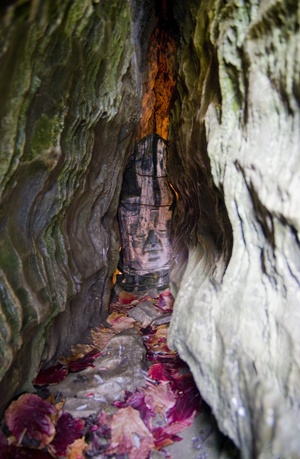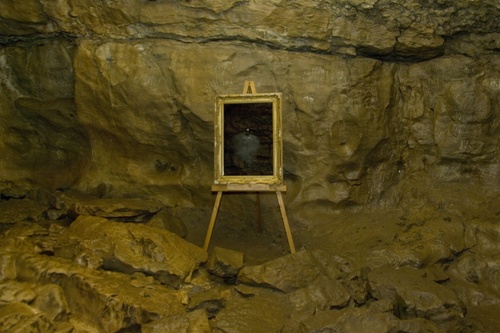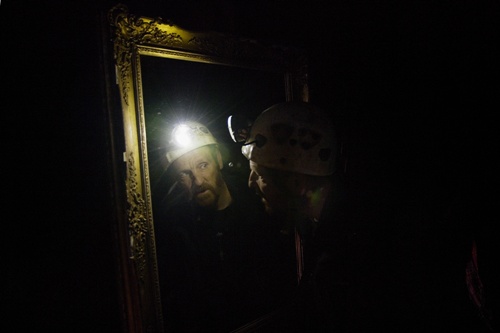The Fredericks J Fredericks Project: an artist-led journey
19.12.11
Above the village of Llangattock in Powys, the disused limestone quarry cuts a long horizontal scar into the hill. If you climb up to the old tram track which runs along the foot of the workings, you'll notice a considerable number of cave entrances, mostly little more than distended fissures in the cliff, but sometimes big enough to walk or at least to crouch through.
Wriggle down into the cave of Eglwys Faen and you find yourself immediately in a large cavern off which other smaller chambers and tunnels veer away. If you shine a torch onto the walls of this cavern you'll discover that they are covered in graffiti – names, sometimes dates, an occasional portrait; often hastily done in pencil or chalk, but sometimes laboriously carved into the rock. Many specimens go back a couple of hundred years and more – Frederick J Fredericks, for instance, wrote his name in 1787. Names everywhere, those of the living and the dead, and under the names more names, faint, difficult to make out, all hanging there in the bat and drip-infested quiet.
The Frederick J Fredericks collaborative project started to take shape after a visit by a group of artists and writers to this astounding place. The idea at first was to work in and around the caves, but it quickly became evident that the project would spill out over the landscape, far off down the precipitous slope to the valley floor. Which is why, on Sunday October 31st 2011, a group of intrepid spectators led by caver Steve Booker sets off walking from Llangattock, heading for the path which follows the lower part of the old tramway.
In a brook, near the foot of the steeply ascending track they come upon the first of the installations: Stefhan Caddick's spindly low-tech water-turbine attached to a set of LED bulbs. The bulbs spell out the sombre text "No Future" – apt perhaps in a time of economic and environmental crisis. A stark message, anyway; and yet there is something cheering – resolutely human – about this little machine quietly purring under the trees.
A little way on, the tramway begins its sharp ascent, hard going at the best of times, but especially after a day of torrential rain. In places the rocky path is little better than a stream-bed, water pouring through the channels worn in the stones by cables which had once drawn the trams up and lowered them down again. Everywhere traces of an immense, now defunct activity. The audience begins to climb, and as they stumble higher, the wood alongside them erupts into a ricocheting turmoil of voices: six poets hidden among the trees, bellowing and chanting through oversized traffic cones. John Goodby, Christopher Twigg, Lyndon Davies, Anthony Mellors, Graham Hartill and finally Scott Thurston, all gabbling and rapping their messages for the spirits of the place, throat-singing, honking, imprecating and invoking and then, as the audience climbs beyond them, falling silent again.
A brief interval for pomegranates, Persephone's fruit (after all it's the time of the dead, or nearly – Samhain, All Souls, or All Saints, Halloween), and the weirdly urgent music of the crwth, an ancient bowed lyre-like Orphic instrument, played by musician Gillian Stevens. Then a last climb to the horizontal quarry track. Near the juncture at the top Tessa Waite has decorated a squat tree with brightly coloured buttons and feathers, ferns and bows, almost like little charms or talismanic favours, so delicately domestic, somehow, in this wild space.

Crying by Susan Adams (photo © Phil Martin)
A half a mile further on there is a point where a number of caves emerge gaping and wheezing cold air into the daylight. Poet David Greenslade is charging about with a gong; a pair of swan's wings arch angelically from his rucksack. In a chink in the rock, Susan Adams' beautifully carved rustic wooden satellite-dish points out over the landscape, listening for whatever is out there, whatever the air is invisibly full of or indeed empty of; in the dish itself two eyes weep continually as if the messages coming in are just too much or too little for it.
Nearby, strange sounds emerge from a narrow cleft. Inside, Penny Hallas has created a kind of votive space. On a piece of cloth lit from behind, one can just make out a face whose eyes seem to be emitting jets of energy; the floor is strewn with red and yellow leaves; a sheep's spine occupies a niche at the entrance. The air is alive with sounds: bells, musical boxes, cars, farmyard baas and clucks and buglings, a bodiless mumbling and swelling of human voices in chorus, snatches of poetry and conversation.

Untitled by Penny Hallas (photo © Phil Martin)
Just around the corner is the path to the main cave. We scramble up this last narrow twisting incline and squeeze one by one into Eglwys Faen. As you enter, the first thing you see in the middle distance are little constellations of coloured lights. The air is full of the slapping noise of falling water and beyond that a strange deep-seated rumbling and wailing, which builds the further in you go until you would swear the earth itself was singing. The lights are attached to two metallic sculptures by Chris Nurse, sparkling red, white and blue like fairground machines. Each bears a portrait and a name, and an arrow pointing to the rock wall. Andrée Peel – French Resistance fighter, I discover later – survived Buchenwald, died at 105. George Alfred Barnard, mathematician, socialist, teacher. Two names, two faces, two biographies, glittering like showbiz in the earth's entrails.

The Enlightenment of Frederick J Fredericks by Morag Colquhoun (photo © Phil Martin)
Nearby is Morag Colquhoun's huge framed mirror with one perfectly round bullet hole piercing the glass. If you look through the hole you find yourself looking into what at first glance resembles a sort of paradisal cloud with a glowing core, but which eventually you realise is a photographic image of the entrance to the cave. The way in is the way out. According to a newspaper of the time, Frederick J Fredericks won a bet that he could shoot a gun through a pub mirror without shattering it.

The Enlightenment of Frederick J Fredericks by Morag Colquhoun (photo © Phil Martin)
The music is still building, is now a plangent, rattling, heart-furrowing roar from the back of the cave. This is Outdoor Sports building to a climax. There are people everywhere, stumbling, or standing like chunks of solidified darkness, picked out occasionally by a passing torch beam. Presences: the forms of the ones who are here now and the ones who came before and are no longer here, maybe, or perhaps...
Outside the light is beginning to fail.
Lyndon Davies
For more information and links, go to: www.stefhancaddick.co.uk/new/frederick-j-fredericks/